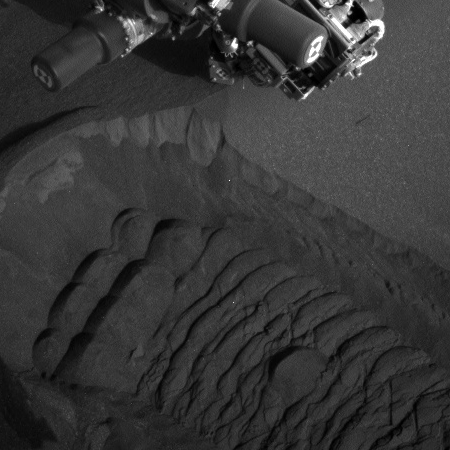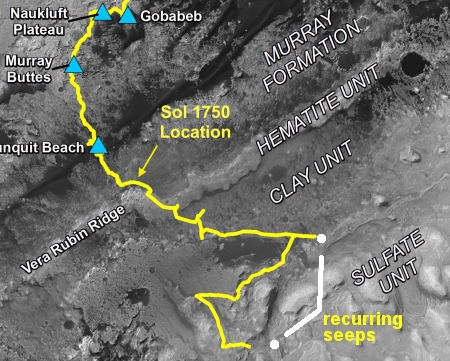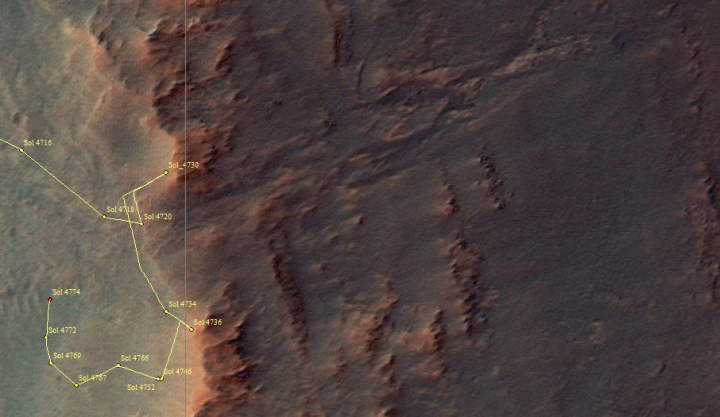Mars rover update: July 12, 2017
Summary: Curiosity looks at some big dune ripples, then creeps up hill. Opportunity tests its wheels.
Curiosity
For the overall context of Curiosity’s travels, see Pinpointing Curiosity’s location in Gale Crater.

Since my last update on June 23,, Curiosity has worked its way around and, for a few days, even into the small sandy field at the base of Vera Rubin ridge. The scientists noticed that the sandy here had a series of large ripples, and they wanted to take a close look at at least one. The image on the right, cropped to show here, was taken shortly after they had the rover drive through one ripple in order to expose its interior. You can see the robot arm directly above the cut created by the rover’s wheels. On the cut’s wall several distinctly different toned layers are visible. A close look reveals that they are wavy, and probably indicate numerous and repeated overlays as the wind brushes a new layer of dust on top of old layers, time after time. The different tones indicate a change in the material’s composition, which could reveal something about some past events in either Mars’ weather or geology.
In order to decipher this information, however, they will need to be able to date the layers, and figure out when each tonal change happened. I am not sure Curiosity can do this, especially since they have not scooped up any of this dust for later analysis.
They are now approaching Vera Rubin Ridge, and should climb up onto in the coming weeks. At that point they will move off the Murray Formation, where they have been since March 2016, made up of dried and ancient crushed mud, and up onto a lighter, yellowish layer of rock, dubbed the Hematite Unit. This October 3, 2016 press release. gives a good outline of the geology of these regions.

Yesterday the Curiosity science team released a map showing where Curiosity is at this moment, but also indicated their planned route in the coming months. I have included a cropped version on the right.
What is significant about this proposed route is that it reveals that they have made the decision to visit at least two of the recurring black streaks that might be intermittent seeps of water flowing downhill that happen to be within reach of the rover’s planned travels. I have added white dots to the map on the right to show where those two seeps are. Back in October they had been unsure whether to do this because of concerns of contaminating the seeps, since Curiosity was only “partly sterilized” prior to leaving Earth. It appears now that they will at least move the rover very close to the nearest seep, close enough possible to get some spectroscopy and determine whether there is water in those seeps. With the second seep it appears they will place Curiosity in a spot where it can observe that seep from a close distance, and even hopefully observe it change over time.
Opportunity
For the overall context of Opportunity’s travels at Endeavour Crater, see Opportunity’s future travels on Mars.

Since my June 23 update,, Opportunity has continued its careful reconnaissance of the area above the head of Perseverance Valley. They have been doing this partly to understand what is there, and partly because of an issue with the left-front wheel.
It appears though they are satisfied that the rover is still capable of travel, they now need to wait through July because the Sun is presently moving between the Mars and Earth, making communications more difficult. Even so, it is presently unclear if they will risk taking the rover into the valley itself.
On Christmas Eve 1968 three Americans became the first humans to visit another world. What they did to celebrate was unexpected and profound, and will be remembered throughout all human history. Genesis: the Story of Apollo 8, Robert Zimmerman's classic history of humanity's first journey to another world, tells that story, and it is now available as both an ebook and an audiobook, both with a foreword by Valerie Anders and a new introduction by Robert Zimmerman.
The print edition can be purchased at Amazon or from any other book seller. If you want an autographed copy the price is $60 for the hardback and $45 for the paperback, plus $8 shipping for each. Go here for purchasing details. The ebook is available everywhere for $5.99 (before discount) at amazon, or direct from my ebook publisher, ebookit. If you buy it from ebookit you don't support the big tech companies and the author gets a bigger cut much sooner.
The audiobook is also available at all these vendors, and is also free with a 30-day trial membership to Audible.
"Not simply about one mission, [Genesis] is also the history of America's quest for the moon... Zimmerman has done a masterful job of tying disparate events together into a solid account of one of America's greatest human triumphs."--San Antonio Express-News

